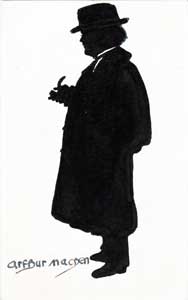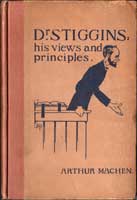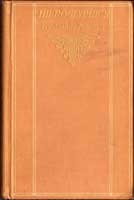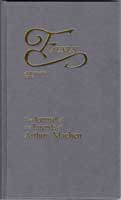James Branch Cabell and Arthur Machen
by Mark Valentine
Reprinted from Faunus No. 4, Autumn 1999
 One of the most eminent of the American admirers of Arthur Machen's work was that great fantasist James Branch Cabell (1879-1958). Perhaps because his many volumes of high romance are liberally laced with irony and independence of imagination, Cabell has never quite earned the unreserved affection of genre enthusiasts, though Ballantine paperback reprints of several of his books in the sixties and seventies have helped to keep him in the favour of a few. But Cabell should also have the distinction of being one of the earliest Machen aficionados in his country, long before the vogue of the Twenties which lead Knopf to publish so much of his work. Cabell recalled in a letter to Vincent Starrett of November 8, 1917: "It was eleven years ago that I was impressed by an unfavorable review of The House of Souls and made it my business to procure the volume. Then felt I like some watcher of the skies &c, in cold sober earnest. That his book— personally, I still rank it as Machen's best— should still remain almost unknown, is really the sort of crime that ought to be discussed from house-tops with Biblical invectives." It is characteristic of Cabell that it should be an unfavourable review which led him to Machen: for much of his own writing career, he felt at odds with the prevailing literary shibboleths and he seems to have discerned in Machen at once a kindred spirit. Cabell went on to observe to Starrett how difficult it was to find Machen's books, adding that he had only obtained The Hill of Dreams, Dr Stiggins and Hieroglyphics, but had put in a good word for The Terror at the offices of the publisher McBride.
One of the most eminent of the American admirers of Arthur Machen's work was that great fantasist James Branch Cabell (1879-1958). Perhaps because his many volumes of high romance are liberally laced with irony and independence of imagination, Cabell has never quite earned the unreserved affection of genre enthusiasts, though Ballantine paperback reprints of several of his books in the sixties and seventies have helped to keep him in the favour of a few. But Cabell should also have the distinction of being one of the earliest Machen aficionados in his country, long before the vogue of the Twenties which lead Knopf to publish so much of his work. Cabell recalled in a letter to Vincent Starrett of November 8, 1917: "It was eleven years ago that I was impressed by an unfavorable review of The House of Souls and made it my business to procure the volume. Then felt I like some watcher of the skies &c, in cold sober earnest. That his book— personally, I still rank it as Machen's best— should still remain almost unknown, is really the sort of crime that ought to be discussed from house-tops with Biblical invectives." It is characteristic of Cabell that it should be an unfavourable review which led him to Machen: for much of his own writing career, he felt at odds with the prevailing literary shibboleths and he seems to have discerned in Machen at once a kindred spirit. Cabell went on to observe to Starrett how difficult it was to find Machen's books, adding that he had only obtained The Hill of Dreams, Dr Stiggins and Hieroglyphics, but had put in a good word for The Terror at the offices of the publisher McBride.
More significantly still, Cabell sent Starrett his own romance The Cream of the Jest, "because I detect therein the Machen influence—the Machen of 'The Hill of Dreams'. Starrett's response (on December 5, 1917) was enthusiastic: "I am convinced of one thing—that it is a very great book. It leaves me bewildered with the bigness of its vision...It is one of the biggest things I have ever read; I wish I had written it. I wish Machen could read it. Please send him a copy... I felt this way about Machen, when I read The Hill of Dreams, that appallingly desolate record of a life. I felt that I couldn't do him justice; but how I wanted to!"
Cabell in reply was somewhat overwhelmed, though not inclined to entirely repudiate the praise: "Your letter very positively embarrasses me. I had hoped The Cream of the Jest might interest you because of the Machen influence, which I at any rate detect therein, from The Hill of Dreams and 'A Fragment of Life,'—but when it comes to telling me that you think it is a really great book, in such superlatives, I can but be dubious and embarrassed and, above all, delighted." In response to questions from Starrett about the book's potentially multiple meanings, Cabell notes: "Perhaps I had best refer you to Horvendile's declaration at Storisende, that we dreamers hunger for we know not what, and for the exercise of powers we know that we possess, without knowing what they are."
The Cream of the Jest is one of a handful of books that have been compared to The Hill of Dreams, and almost always the comparison is at first likely to lead to disappointment: Jack London's The Star Rover, E.H. Visiak's Life's Morning Hour, each have excellent qualities of their own, and an element of visionary ecstasy which has prompted the comparison, yet each lacks quite the ardour and the fine expression of Machen's classic. Likewise, the first reading of The Cream of the Jest will also lead to some doubt. Cabell's style is far more urbane and his prose craft more consciously elevated than is the case with Machen. However, The Cream of the Jest resembles The Hill of Dreams in its portrayal of a writer who is oppressed by the humdrum banalities of everyday existence and finds himself increasingly drawn to an inner world of dreams. Just as Machen is biting about the petty viciousness and snobbery of 'Caermaen' society, so Felix Kennaston, Cabell's protagonist, is bitter about the triviality of his fictional city of Lichfield, mostly mediated to him through his ambitious wife. Lucian Taylor's reveries in The Hill of Dreams come to be a conscious experiment in the alchemy of the mind, an exploration of the mingling of the sensual and the spiritual: Kennaston too is drawn to deliberately seek out the alternate-world domain of what was originally an involuntary vision, and finds a life there at once more colourful and more aristocratic.
 After Starrett had sent Cabell his essay on Machen, later to be published as A Novelist of Ecstasy and Sin, Cabell leapt to the defence of Dr Stiggins, in a letter of January 4, 1918: "And I think you underrate Dr Stiggins, which I protest has 'permanent interest,' for the simple reason that Stiggins is, worse luck, immortal and seized of steadily augmenting power. I grant you, though, that to read a book of which every word means the exact contrary to what it seems to assert becomes, in the outcome, fatiguing. For that I don't blame Machen, but my mental limitations." It is perhaps not surprising that Cabell was able to relish Dr Stiggins, for his own work makes telling use of similar satire, and he was to be constantly in feud against the puritan and mercantile morality that Machen's bête noire personifies. However, this must remain one of the few acclamations for Machen's least-appreciated book. Cabell had followed up Starrett's suggestion of sending Machen a copy of The Cream of the Jest, and on February 17, 1918 (characteristically dated simply "Sexagesima" by Machen), he had his reply: "Pray let me thank you most heartily for your curious, singular & enchanting book...I have read it with admiration & delight. It is, indeed, beautifully done; you have all my congratulations." Machen adds, cryptically, "But I do not know whether you know all that is
After Starrett had sent Cabell his essay on Machen, later to be published as A Novelist of Ecstasy and Sin, Cabell leapt to the defence of Dr Stiggins, in a letter of January 4, 1918: "And I think you underrate Dr Stiggins, which I protest has 'permanent interest,' for the simple reason that Stiggins is, worse luck, immortal and seized of steadily augmenting power. I grant you, though, that to read a book of which every word means the exact contrary to what it seems to assert becomes, in the outcome, fatiguing. For that I don't blame Machen, but my mental limitations." It is perhaps not surprising that Cabell was able to relish Dr Stiggins, for his own work makes telling use of similar satire, and he was to be constantly in feud against the puritan and mercantile morality that Machen's bête noire personifies. However, this must remain one of the few acclamations for Machen's least-appreciated book. Cabell had followed up Starrett's suggestion of sending Machen a copy of The Cream of the Jest, and on February 17, 1918 (characteristically dated simply "Sexagesima" by Machen), he had his reply: "Pray let me thank you most heartily for your curious, singular & enchanting book...I have read it with admiration & delight. It is, indeed, beautifully done; you have all my congratulations." Machen adds, cryptically, "But I do not know whether you know all that is  to be known concerning small mirrors: but of this, silence." The reference is to a passage in the book where Kennaston has received popular acclaim for a novel in which such pocket mirrors are used, and subsequently has strange encounters with eminent people who evidently think, because of this reference and others, that he is a fellow initiate in some unspecified mystery. Machen possibly had in mind the use of mirrors as scrying glasses, for purposes of divination and communication with spiritual realms, and his silence on the matter may be because he had already begun to draw away from his overt interest in the esoteric and hermetic in favour of a High Church faith. It is a typical slyly mysterious aside, of the sort that permeate The House of the Hidden Light, his strange epistolary allegory written with A.E. Waite.
to be known concerning small mirrors: but of this, silence." The reference is to a passage in the book where Kennaston has received popular acclaim for a novel in which such pocket mirrors are used, and subsequently has strange encounters with eminent people who evidently think, because of this reference and others, that he is a fellow initiate in some unspecified mystery. Machen possibly had in mind the use of mirrors as scrying glasses, for purposes of divination and communication with spiritual realms, and his silence on the matter may be because he had already begun to draw away from his overt interest in the esoteric and hermetic in favour of a High Church faith. It is a typical slyly mysterious aside, of the sort that permeate The House of the Hidden Light, his strange epistolary allegory written with A.E. Waite.
In response, Cabell reiterated his high regard for Machen's work, noting that he had found few until recently to share his enthusiasm, except Starrett, but had lately begun to notice more talk about his books: "In short, sir, it really looks as though all our American bookbuyers were not condemned to eternal idiocy, and as though a spark or two of intelligence were flickering somewhere among their doddering ranks". What Cabell expresses so strongly in relation to the reception of Machen's work, he probably felt equally about his own.
Machen, in response on April 8 1918, was grateful: "You write the cheering word. & I assure you. Sir, I have need of it"—he was still locked in those days in the dreary chores of the Evening News— and proceeded to elaborate on his own pleasure in The Cream of the Jest, "I have been re-reading your book with very great pleasure. I think that there is a very exquisite skill in your dissolution of the spell, as it were; in your identification of the Seal with the top of a cold cream vase—& yet the truth of the vision remains. It was the fatal & most abominable error of protestantism not to see this, not to see that the art of life is to pass thro' things temporal so that we lose not the things eternal: the eternal things which are hidden under the temporal veils". In using a humble object as the talisman for his quest, Cabell was indeed honouring a lifelong Machen dictum, which probably has its most concise expression in the prose piece "The Holy Things" (from Ornaments in Jade, not at that time published), in which the typical sounds and sights of a London street are transformed for one individual into the elements of a sacred rite.
 Cabell next found another Machenophile in the editor Burton Rascoe, and wrote to him on April 23 1918, with some reservations about Hieroglyphics: "how maddeningly it skips from splendid things to profound inanities! His observations about Thackeray, for example, are the dicta of an imbecile ward: and, as always, Machen has an irritating trick of hinting at something which is too awful to talk about... But with all that, he is one of my enthusiasms, and I only wish he were better known." Machen later noted that his thesis in Hieroglyphics,—the supremacy of ecstasy as the touchstone of fine literature—which initially met with denunciation was within a decade to be regarded by some as merely a truism, so Cabell's comments on "inanities" may reflect a similar change in attitude. Cabell noted that he read Hieroglyphics "in the midst of his own bookish fantasy. Beyond Life, and found it "peculiarly interesting", and there are certainly some analogies with his work: but Cabell's work is rather more lightly handled than Hieroglyphics, making playful reference to several lost or unwritten classics of the masters of literature, and sustaining the reader's interest rather better with a livelier fictional framework.
Cabell next found another Machenophile in the editor Burton Rascoe, and wrote to him on April 23 1918, with some reservations about Hieroglyphics: "how maddeningly it skips from splendid things to profound inanities! His observations about Thackeray, for example, are the dicta of an imbecile ward: and, as always, Machen has an irritating trick of hinting at something which is too awful to talk about... But with all that, he is one of my enthusiasms, and I only wish he were better known." Machen later noted that his thesis in Hieroglyphics,—the supremacy of ecstasy as the touchstone of fine literature—which initially met with denunciation was within a decade to be regarded by some as merely a truism, so Cabell's comments on "inanities" may reflect a similar change in attitude. Cabell noted that he read Hieroglyphics "in the midst of his own bookish fantasy. Beyond Life, and found it "peculiarly interesting", and there are certainly some analogies with his work: but Cabell's work is rather more lightly handled than Hieroglyphics, making playful reference to several lost or unwritten classics of the masters of literature, and sustaining the reader's interest rather better with a livelier fictional framework.
 Rascoe tried to interest Cabell in writing an article on Machen, but Cabell put forward Vincent Starrett for the task instead (letter of June 4th, 1918), on the grounds that he "will sound the trumpet far louder than I could do with an untroubled conscience", adding: "I would violently find fault with every book of Machen's except The House of Souls". He is particularly critical of The Hill of Dreams—"do you not see that, where Lucien [sic] trades his corporeal life for dreams, the dreams are not sufficiently indicated for anyone really to believe in them?": by contrast, in his own The Cream of the Jest, "With more or less modesty, I would suggest that while Kennaston drives a not dissimilar bargain, the bargain is indicated, the dreams are indicated, and you have an actual sense of what he got in exchange".
Rascoe tried to interest Cabell in writing an article on Machen, but Cabell put forward Vincent Starrett for the task instead (letter of June 4th, 1918), on the grounds that he "will sound the trumpet far louder than I could do with an untroubled conscience", adding: "I would violently find fault with every book of Machen's except The House of Souls". He is particularly critical of The Hill of Dreams—"do you not see that, where Lucien [sic] trades his corporeal life for dreams, the dreams are not sufficiently indicated for anyone really to believe in them?": by contrast, in his own The Cream of the Jest, "With more or less modesty, I would suggest that while Kennaston drives a not dissimilar bargain, the bargain is indicated, the dreams are indicated, and you have an actual sense of what he got in exchange".
This is a curious criticism from Cabell, who in other matters was astute about Machen's work. Some of Lucian's visions, such as those in the Roman tavern and the episode of the slave and the noblewoman, are surely very precisely delineated: the nature of others, for example the mingling and interchange of sense-impressions, are also sufficiently implied for the reader to appreciate; and in any event a certain air of elusiveness and inexpressibility is an appropriate approach for the conveying of realms beyond. By contrast, in Cabell's work, the explicit narrative progression of the dreams and their vivid historical character make them seem more like reincarnation or past life fantasies: they are therefore much less beguiling as metaphors for an ethereal visionary state.
Thereafter, Cabell's correspondence is less enlightening about his interest in Machen. However, it is interesting to note that Machen was equally appreciative of Cabell's notorious masterpiece Jurgen (which we may perhaps assume had also been sent to him by Cabell) as he was of The Cream of the Jest, though he did not wish to claim any direct influence on the work. He wrote to Tom Horan: "I know it is said that Mr. Cabell derives from me; but it strikes me that his obligations are slight enough. I told him as much, in answering a very friendly letter, acknowledging his indebtedness. In one of my books, The Chronicle of Clemendy, I owe a great deal to Balzac's Contes Drolatiques, and I rather gathered from Jurgen that Mr. Cabell had also glanced at that delightful work."
There is indeed a significant divergence in the work of Machen and Cabell. They had in common a consciously crafted high prose style, an allegiance to aristocratic or traditional virtues, a robust pleasure in the bawdy, and a disdain for the trivialities of everyday existence. They were both adept at deploying satire and fantasy in the service of their convictions. But while Machen strove to convey the secret depths implicit in the workings of "sorcery and sanctity" because he ardently believed in the superior reality of these, Cabell's engagement with the mystical and wondrous is much more inflected with irony, sardonic mockery and reserve. There is almost a century's stretch of difference between their attitudes: Machen's seems to belong with the rather fevered embrace of both Catholicism and diabolism characteristic of the Nineties, while Cabell's seems to foreshadow the postmodern sense of distance and denial of the necessity to commit to single perceptions of reality. There are rewarding virtues in both of their canons, but they do not derive from similar visions.
Acknowledgements: Thanks to Peter Relton for his assistance with Cabell material
